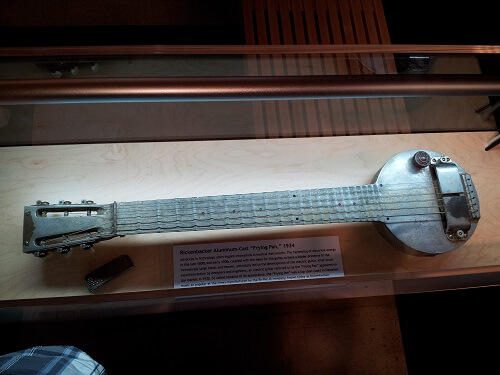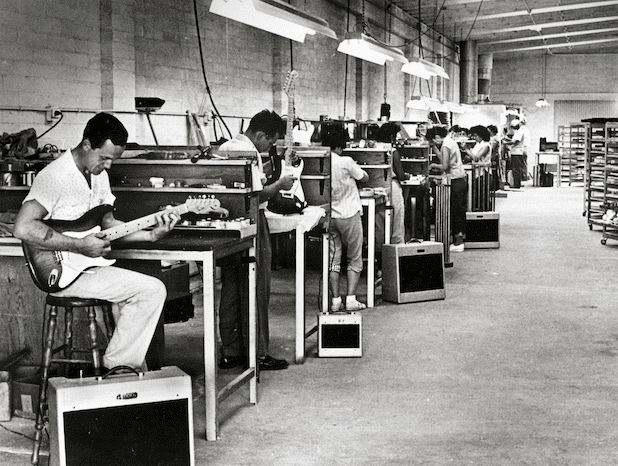Who invented the electric guitar (EG)? According to the official version, the EG was created in the 1920s in Los Angeles (LA) by engineer Lloyd Loar. He at the time worked for Gibson, a well-known musical instrument company. However, there are many contradictory opinions about who Lloyd really was and whether he was the one who first invented the EG technology. Read more at la-future.
How the idea for the EG came about

In fact, archaeologists have discovered traces of stringed instruments, such as the harp, which are now about 3,500 years old. During this period the first guitar was created. The instrument was used by the Egyptian singer Ḥar-Mosě.
He used a model that can be considered a beta version of the guitar. It consisted of three strings and a polished cedar sound box covered in leather.
At the start of the 20th century, there was a need to think more seriously about a solution that could amplify the sound of acoustic guitars. This would allow musicians to perform in large rooms while maintaining the power of sound. This explains the invention of the electric amplifier (specifically for the guitar).
Some engineers and researchers worked on electrifying the sound directly from the instrument in an attempt to respond to the complaints of musicians and music lovers of the time.
The principle is to capture the vibrations of the tool, convert them into electrical waves and transmit them through cables to a special amplifier.
Who is Lloyd Loar

Born in Cropsey and raised in Lewiston, Loar is one of the most important figures in American music history. However, today his name is almost forgotten, except for collectors of vintage instruments. Loar essentially founded bluegrass music (one of the original American musical concepts, like jazz and blues) through Bill Monroe and the iconic Lloyd Loar F5 mandolin.
Every typical bluegrass mandolin today is shaped like a Gibson F-5. L. Loar invented and designed it. They are the Stradivarius of the mandolin world. The instruments are also in high demand. He designed the L-5 Gibson EG as well. L. Loar went on to design the first EGs, mandolins and violins.
Many believe that L. Loar did not work at Gibson as an instrument maker. He was a musician with a strong interest in musical acoustics. At Gibson, he led the design and development of several instruments and accessories.
Loar was hired by Gibson as a contractor. His contribution to Gibson’s line of instruments was like that of Les Paul (1915-2009), whose ideas and contributions led to the growth and expansion of Gibson’s production of solid body EGs.
Indeed, many other musicians have maintained relationships with Gibson over the years, resulting in models named after them. Coincidentally, L. Paul played an F5 mandolin signed by L. Loar.
The first EG, the “Frying Pan”

Jazz musicians quickly recognized the need to amplify the guitar’s sound. It was very difficult to hear the guitar among the brass bands that accompanied it. So, from 1920 to 1924, L. Loar conducted the first experiments at the Gibson manufacturing house to get an innovative EG model. He strived for an instrument that would have more amplification power.
In 1920, engineer L. Loar created the first EG in the U.S. This invention was made possible by a moving coil microphone at the start of the century. This dynamic microphone made a real revolution. One could record music with it.
So, the engineer combined this microphone with a Hawaiian guitar to create what is now called an EG.
We had to wait a few years before the EG was released on the market and presented in a form comparable to the one that is well known to everyone today.
In 1931, the “Frying Pan” was sold in the U.S. by Rickenbacker. It costs about EUR 2,500 today. The “Frying Pan”, developed in the 1930s (between 1931-1932), received a patent in 1937. It was played on the knees, had no sound box and the pickups were added to the guitar’s body.
Gibson Guitar Corporation

The corporation created by Orville Gibson was founded in 1902. The luthier was a fan of the mandolin. He filed a patent for the latter before the creation of his company in 1898.
O. Gibson made the earliest documented instrument, a 10-string guitar, in 1894. In his workshop in Kalamazoo, Michigan, this former shoe salesman combined his love of woodworking and passion for music into new mandolin and guitar designs. O. Gibson created his new mandolins and guitars to look like violins with carved tops.
Gibson archtop acoustic guitars gained popularity in the 1920s and 1930s. While the archtop remains typical of Spanish-style performers, dance bands, swing bands and western outfits, the decade gave way to flat-top acoustic guitars. Other manufacturers have already made waves in the new market.
Around the end of the 1910s, O. Gibson released its first line of flat-top guitars, the Navy model, intended primarily for military personnel at the end of World War I.
L. Loar resigned in 1924 when Gibson’s management disapproved of one of his new radical projects. During the Great Depression, Gibson entered the toy market and began making violins. He introduced the Kalamazoo, an inexpensive line of acoustic guitars.
Gibson began making archtop guitar bodies in the 1930s with the Kay guitar company. At the time, Kay was a relatively small company. Nevertheless, it had a good reputation for its budget-friendly instruments. Gibson helped Kay expand their operations. Together they produced some of the most famous archtop guitars ever made, including the Super 400 and the Stromberg Master 400. Although Gibson eventually stopped working with Kay, the company continued to produce high-quality archtop guitars. Today, Kay is one of the most respected names in the guitar world. Their archtop guitars are very popular with collectors and players alike.
The EG’s evolution

In 1935, Gibson began producing the ES-150, an F-hole guitar with a single pickup. The model was very successful at the time.
In 1948, Leo Fender introduced the first solid body EG, the Broadcaster. It later became the Telecaster. It was a full-body EG with a bridge pickup and a neck fastened with four screws. The body was made of ash. The neck was made of maple.
Later, another pickup was added to the Telecaster, this time on the neck. A switch was also added to change the pickups. There were three combinations, namely, pickups on the neck, 2 pickups together, pickups on the bridge and both pickups together. In 1952, Gibson decided to counter the success of the Telecaster by creating the Gibson Les Pauls.
The Les Paul is a solid body EG made from a single piece of mahogany with a top made of maple, 2 P90 pickups, serial humbuckers (unlike the Telecaster, which had 2 single coil pickups) and a neck (mahogany with rosewood fretboard) glued together with the body. Both EGs were successful.


